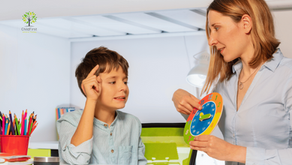Toilet Training: 10 Tips for Children with Unique Needs
- ChildFirst Behavior Therapy

- Apr 14, 2024
- 6 min read

Toilet training can be a challenging milestone for any child, but it can be particularly daunting for children with unique needs. Whether your child has a developmental delay, a physical disability, or receptive issues, navigating the toilet training process requires patience, understanding, and tailored strategies. Here are ten tips to help parents and caregivers support children with unique needs through this important developmental stage. Additionally, seeking guidance from professionals who specialize in Center-based ABA therapy can provide valuable insights and personalized strategies to facilitate the toilet training process effectively.
Start When They're Ready:
Starting toilet training when your child is truly ready is paramount, particularly for children with unique needs. While it might be tempting to initiate the process based on age milestones or external pressures, it's essential to recognize and respect your child's individual readiness cues.
For children with unique needs, the developmental journey may unfold differently compared to their peers. They may require more time to understand and internalize the concepts associated with toilet training. Rushing the process can not only lead to frustration but also hinder their progress and confidence.
Create a Visual Schedule:
Creating a visual schedule can significantly aid children with unique needs in understanding and following the steps of using the toilet. Visual aids serve as concrete reminders of routines and expectations, providing clarity and structure. For instance, a simple visual schedule might include steps like pulling down pants, sitting on the toilet, using the bathroom, wiping, flushing, washing hands, and pulling up pants. Each step is accompanied by an easy-to-understand image or symbol, reinforcing the sequence of actions. Regular review of the visual schedule helps solidify the routine in the child's mind, promoting independence and confidence in their toileting skills. By incorporating visual supports, caregivers can effectively support children with diverse learning styles through the toilet training process, facilitating their understanding and mastery of this essential life skill.
Choose the Right Equipment:
Choosing the appropriate equipment is crucial when toilet training a child with unique needs. Depending on your child's specific requirements, you may need to consider investing in specialized items such as a toilet seat reducer, step stool, or adaptive toilet seat. These tools can provide the necessary support and assistance to facilitate the toileting process for your child. It's essential to ensure that the chosen equipment is not only comfortable but also safe for your child to use. Additionally, consulting with a healthcare professional can offer valuable insights and recommendations tailored to your child's individual needs. By selecting the right equipment and seeking professional guidance, you can create a supportive environment that promotes your child's comfort, independence, and success in toilet training.
Use Reinforcement and Rewards:
Utilizing reinforcement and rewards can be a highly effective strategy when toilet training children with unique needs. Positive reinforcement serves as a powerful motivator, encouraging your child to continue making progress in the toilet training process. It's essential to praise your child for each successful step they take, whether it's sitting on the toilet, using it independently, or washing their hands afterward. Positive affirmations such as "Great job!" or "I'm so proud of you!" can go a long way in boosting your child's confidence and self-esteem.
In addition to verbal praise, implementing a reward system can further incentivize your child's efforts. Consider using stickers, small treats, or other preferred rewards to celebrate milestones along the way. For example, your child could earn a sticker for each successful trip to the toilet or receive a special treat for mastering a new skill. By associating positive experiences with the toilet training process, you can help make it a more enjoyable and rewarding experience for your child.

Practice Patience:
Patience is paramount when it comes to toilet training, particularly for children with unique needs. Understanding that each child progresses at their own pace is essential, and it's crucial to be prepared for setbacks and accidents along the way. Children with unique needs may require more time to grasp the concepts and routines associated with toilet training, and they may face additional challenges or barriers.
Approaching the toilet training process with patience, understanding, and encouragement can make all the difference. Instead of becoming frustrated or discouraged by setbacks, view them as opportunities for learning and growth. Offer your child reassurance and support, emphasizing that mistakes are a natural part of the learning process.
Offer Choices:
Offering choices can be a valuable strategy when toilet training children with unique needs. Providing opportunities for autonomy and decision-making can empower your child and foster their sense of independence and ownership over the toilet training process.
One way to incorporate choices is by allowing your child to select their own underwear. Presenting them with options and letting them choose their preferred style or color can make them feel more involved and invested in the process. Additionally, allowing your child to choose the time they want to sit on the toilet can give them a sense of control over their routine. Whether it's offering options for morning or afternoon toilet sessions, providing flexibility can help accommodate your child's preferences and needs.
Model Behavior:
Children learn by example, so consider modeling appropriate toilet behavior for your child. Let them observe you or an older sibling using the toilet, and talk them through each step of the process calmly and reassuringly.
Seek Professional Support:
If you're struggling with toilet training your child with unique needs, don't hesitate to seek support from healthcare professionals such as pediatricians, occupational therapists, or behavioral therapists. They can offer personalized guidance and strategies tailored to your child's specific needs.
Celebrate Progress, Not Perfection:
Remember that toilet training is a process, and progress should be celebrated even if it's not perfect. Focus on the small victories and milestones your child achieves along the way, and celebrate their efforts and accomplishments.
Conclusion
In conclusion, toilet training children with unique needs requires patience, understanding, and flexibility. By following these ten tips and adapting them to suit your child's individual needs, you can support them through this important developmental milestone and set them up for success in the future.
If you need further assistance or guidance in supporting your child's unique needs during toilet training, don't hesitate to reach out to professionals for help. Child First Behavior Therapy offers personalized support and ABA Therapy Services in Arlington Heights. Contact us today at ChildFirst Behavior Therapy to learn more about how we can support your child and family.
FAQs

How do I know if my child is ready for toilet training?
Look for signs of readiness such as staying dry for longer periods, showing interest in the bathroom, or communicating discomfort with wet or soiled diapers. Every child is different, so it's essential to observe your child's cues and readiness indicators.
How can I encourage my child to cooperate during toilet training?
Offer choices whenever possible to empower your child and make them feel more involved in the process. Allow them to choose their underwear or the time they want to sit on the toilet. Positive reinforcement and rewards for successful steps can also motivate your child.
What if my child is resistant to toilet training?
Practice patience and understanding. Understand that setbacks and accidents are a natural part of the learning process. Approach challenges with patience, reassurance, and encouragement. Seek professional support if you're facing significant difficulties.
How can I help my child understand the toileting process?
Use visual schedules and modeling behavior to help your child understand the steps involved in using the toilet. Review the visual schedule regularly and provide verbal guidance and support during each step of the process.
When should I seek professional support for toilet training?
If you're facing challenges or difficulties with toilet training your child with unique needs, don't hesitate to seek support from healthcare professionals such as pediatricians, occupational therapists, or behavioral therapists. They can offer personalized guidance and strategies tailored to your child's specific needs.
How can I celebrate my child's progress in toilet training?
Celebrate every milestone and accomplishment, no matter how small. Focus on the progress your child is making rather than perfection. Offer praise and rewards for their efforts, and celebrate their successes to reinforce positive behavior and motivation.
What if my child has physical disabilities that affect toilet training?
Adapt the toileting environment and equipment to accommodate your child's physical needs. Consider using specialized equipment such as adaptive toilet seats or grab bars. Consult with healthcare professionals for recommendations tailored to your child's specific abilities and challenges.
How can I maintain consistency in toilet training across different environments?
Communicate with caregivers, teachers, and other adults involved in your child's care to ensure consistency in toilet training routines and strategies. Share the visual schedule and any specific accommodations or techniques that have been effective for your child.







Comments